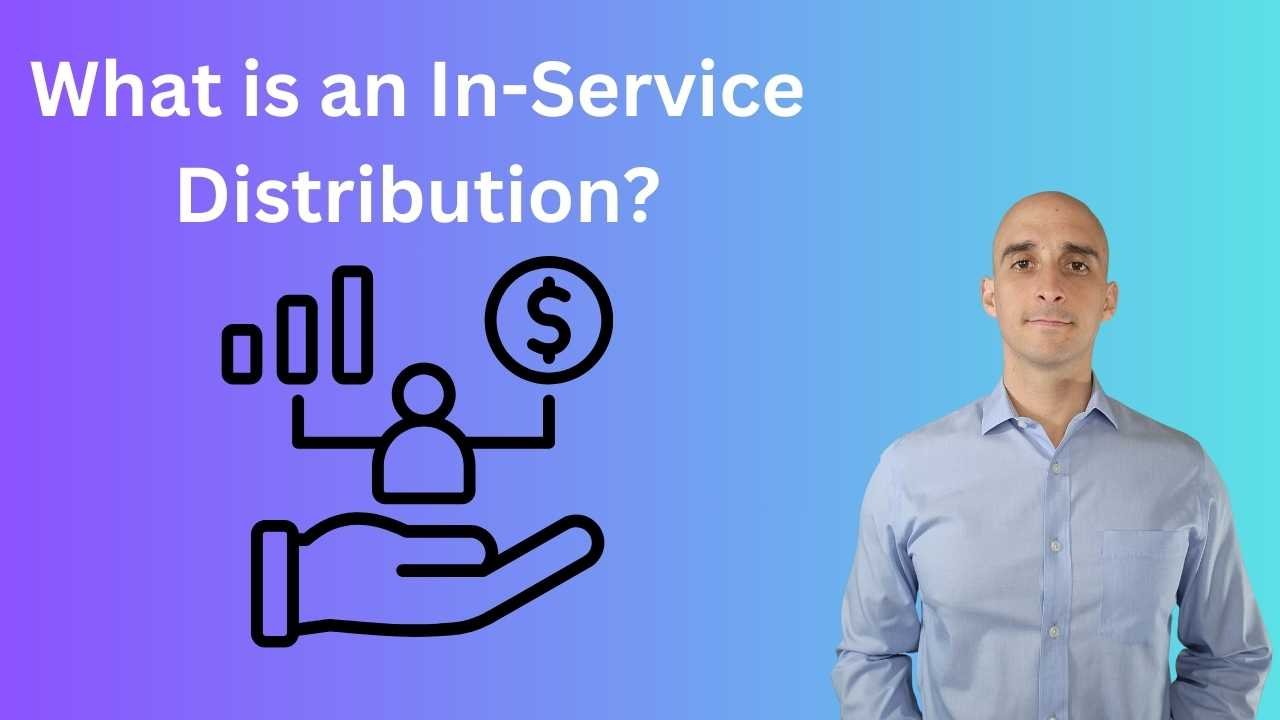What are In-Service Distributions?
In-service distributions, also known as in-service withdrawals, are distributions taken from your employer sponsored retirement plan (a 401 k is the most common example) while you still work for the employer.
From a proactive retirement planning perspective, there are many reasons you might consider taking an in-service withdrawal. There are also drawbacks like the loss of protected benefit from creditors.
In this guide we will explain what in-service distributions are, why to consider them, the rules you should be aware of, and the potential consequences if performed incorrectly.
Table of contents:
What is an in-service distribution?
Why would you consider in-service withdrawals?
What are the in-service withdrawal rules?
What are the hardship distribution exceptions?
What is an in-service rollover?
When would you consider an in-service rollover?
Short Summary
In-Service Distributions are withdrawals from employer sponsored retirement plans while still employed with the plan holder.
This can be a useful way to supplement income.
You need to consider the rules and regulations in order to avoid penalties and excessive tax liabilities.
What is an In-Service Distribution?
An in-service withdrawal occurs when a current employee takes distributions from their employer sponsored retirement plan (401 k, 403 b, TSP) while you are still employed with the owner of that plan.
This is not to be confused with an in-service rollover, which is the transferring of funds from your employer's retirement plan to other retirement accounts (for example, a traditional IRA).
You ordinarily wouldn’t take money out of your retirement savings unless you retire because there will be early withdrawal penalties or income taxes owed.
However, an in-service withdrawal may be done without penalties if you are over the certain age for full withdrawal discretion as specified by your plan (or 59 ½ for an IRA). Otherwise, you will need special circumstances to avoid the penalties associated with early withdrawals.
Click here to schedule a free no obligation consultation with our Fee Only Fiduciary Financial Planning team.
Why Would You Consider an In-Service Distribution?
You would consider taking in-service withdrawals for any of the reasons that you would take a regular withdrawal from a retirement account. There are potential benefits, but they should be considered carefully. The biggest factor is your financial goals, long and short term.
Rollovers to an IRA
This is the most common reason for an in-service distribution.
In-service rollovers, follow the normal rollover rules which will be discussed below in the “What is an In-Service Rollovers” section. For now, know that the reasons to rollover while in-service are the same as any rollover to a new account.
Direct Distributions
You may be in need of a direct distribution to cover costs of living. The tax implications of an in-service withdrawal can be quite serious if not planned properly.
One example of this is you and your spouse are different ages. One employee's spouse retires because they are aging. To make up the difference in income, spouse 2 who is still working might start taking in-service withdrawals, or a recurring in-service distribution to supplement income.
If under age 59 ½, you will be assessed a 10% additional tax penalty on withdrawals, in addition to your normal tax on any earnings, or contributions made with pre-tax dollars. The two main exclusions are employee death or employee qualifying disability.
Hardship Distributions
There may be a way out of this early withdrawal penalty if you have special circumstances. Sometimes big or unexpected changes occur in your life that require immediate funding. Here is a list from the Internal Revenue Service (IRS), of life events that qualify for in-service distributions without penalty.
These will be explained in more detail, later on in this guide, under the “What are the Hardship Distribution Expenses” section.
Click here to schedule a free no obligation consultation with our Fee Only Fiduciary Financial Planning team.
What Are the In-Service Distribution Rules?
The rules will vary largely based on your individual plan's rules. You will always want to check with your plan administrator to determine their specific rules. This information can sometimes be found in the plan document, which is a summary of terms and conditions for your plan.
Vesting Periods
Vesting periods can have a large impact on your distributions.
Any one company may have completely different rules from another.
Your employer's contributions, if any, will typically have a vesting schedule.
Vesting is a specified length of time before you actually have ownership of funds that your employer has contributed to your account. The employee contributions will always be immediately vested as that is your money.
You can check your account statements to see the difference in balances.
Vesting occurs via one of three ways:
Graded vesting will be a specific percentage of employer contributed funds that becomes available over time. For example, you gain staggered ownership of 20% more of your employer’s contributions each year.
Cliff vesting will give you full ownership of employer contributed funds as soon as you hit a specific length of time with your employer. For example, you go from owning 0% to all 100% of your employer’s contributions once you have been working with them for 3 years.
Immediate vesting means you will have full ownership of employer contributed funds once they land in the account.
Employer sponsored retirement accounts must give you full 100% vesting of employer contributions, including profit sharing contributions, when the plan is ended by the employer, or you hit full retirement age under your specific plan’s rules (whichever comes first).
Roth Conversions
Some employer sponsored plans will either place a limit on the amount that you can convert to a Roth account, or bar you from converting any of the funds in their plan at all.
Converting from an employer sponsored plan to a Roth IRA or Roth 401k, if offered by your employer, will follow the normal Roth conversion rules. This means you will voluntarily incurred tax on the amount converted, based on your ordinary income tax rates, because qualified plans are funded with elective deferrals in the form of pre tax contributions.
The benefit of conversion is turning deferred taxes, into an immediate taxable portion of "current income", for tax free withdrawals in retirement. This is because Roth contributions are made with after tax dollars.
Loans Against your Retirement Plan
Another method of in-service withdrawal is to take a loan out from your employer sponsored retirement plan.
Payments to principal and interest of loans from your retirement plan go back to your account balance.
You can have multiple loans at once but keep them organized and paid.
You may only withdraw up to 50% of your account value, to a limit of $50,000. There are no other special rules or unique circumstances.
Taxation
A withdrawal before age 59 ½ will require you to pay an additional 10% early withdrawal penalty, on top of the mandatory 20% minimum tax withholding (if you’re withdrawing from a tax deferred account). The exception are loans and hardship distributions.
We recommend you always consult with your tax professional or financial advisor before making an in-service distribution.
Click here to schedule a free no obligation consultation with our Fee Only Fiduciary Financial Planning team.
What are the Hardship Distribution Exceptions?
Certain expenses called hardship distributions. The IRS has deemed these as financial hardship or heavy financial need. The following exceptions are still subject to ordinary income tax as a distribution, but they allow you to withdraw from a retirement plan without the 10% early withdrawal penalty:
Tuition, room and board expenses, and related educational fees for the next 12 months of postsecondary education may qualify for penalty free withdrawals.
Medical expenses not reimbursed by medical insurance, if over a certain percentage of your income.
Up to $10,000 of exemption, once per person’s lifetime, for a first-time purchase of an employee's principal residence. This rule mandates excluding mortgage payments from the cost.
Funeral expenses relating to the employee's family.
Medical care of immediate family.
What is an In-Service Rollover?
An in-service rollover is a rollover performed into a personally directed account such as an (IRA) - while still employed with your original employer. This is often done for more investment options in the short term. Not to be confused with rollovers done after leaving a company.
Why would you consider an in-service rollover?
Flexibility.
Financial flexibility rarely isn't gained from rollovers. The 401-k plan is only one example of employer covered plans. However, plan participants will almost always find more flexibility from self-directed accounts.
This can offer you alternative investment strategies that may enable your financial objectives. Remember that your financial health is more than just investing. Trustworthy financial advisors will balance your investment goals with the rest of your life balance.
IRA’s offer significantly more investment options that enable a broader range of portfolio strategies than available within most 401k plans.
When would you consider an in-service rollover?
You will consider an in-service rollover if you want to start moving funds between accounts without taking a direct in-service distribution. You can move funds from many account types such as a 401 k, profit sharing plan, employee stock plan etc. Consult your financial advisor to ensure things run smoothly.
Click here to schedule a free no obligation consultation with our Fee Only Fiduciary Financial Planning team.
What Considerations Should you be Aware of Before Performing an In-Service Rollover?
Transfer Fees
An existing employer sponsored plan will likely charge you fees (albeit small) for transferring your funds out, usually between $20-$50, that will come from your account balance.
Fund Fees
A 401 k does get favorable fee treatment when buying ETFs and mutual funds.
When investing in mutual funds (and some exchange traded funds) the expense ratios can be higher in an IRA.
(Disclaimer: as long as you do your research, you can find plenty of low/no fee funds, and don’t forget the fact that single stocks and bonds do not have any fees associated with purchasing or holding them).
Advisory Fees
If you plan to perform an in-service rollover in order to work with a professional financial advisor who'll manage your investment accounts, be sure to factor in the advisory fee that manager may charge you for the service.
Investment goals
You hopefully match your values with your investment strategy. Keep in mind retirement planning is entirely different before and after retirement.
Inheriting new responsibilities
If you rollover to an IRA, you will need to manage your investments yourself. This includes monitoring performance, reinvesting cash, and conducting your own research.
Overall financial goals
You should plan with your financial advisor what you would like to achieve with your money. This will include planning for your lifetime, potential heirs, and personal goals. Aligning strategy with your values will increase the odds that you execute on your financial action items and ultimately achieve your financial goals. Click here to see an in-depth sample financial plan.
Click here to schedule a free no obligation consultation with our Fee Only Fiduciary Financial Planning team.
FAQs
Is there a list of companies that may allow in-service distributions?
Here is a list of companies/ plan administrators that will allow you to take in-service distributions without needing a hardship exception (mynacfa.com). This is often a rollover.
Are in-service withdrawals from Roth accounts taxable?
In-service distributions from Roth account contributions will not be taxed, as a normal Roth distribution wouldn’t. But the growth will be taxed should your account balance be higher than your contribution amount.
Are in-service distributions subject to the additional 10% income tax for early withdrawals?
In-service withdrawals are subject to the 10% extra early withdrawal tax penalty if you are under the age of 65 (standard full retirement age), or whatever age your plan considers fully retired.
This does not apply to rollovers as you are not “getting paid” from your retirement account.
Other exceptions to the early withdrawal penalty are the hardship distribution list, which have specific rules.
If you found the information above helpful, click here to watch my free Masterclass training that explains how you can increase your income in retirement by up to 30% and avoid running out of money in retirement.






